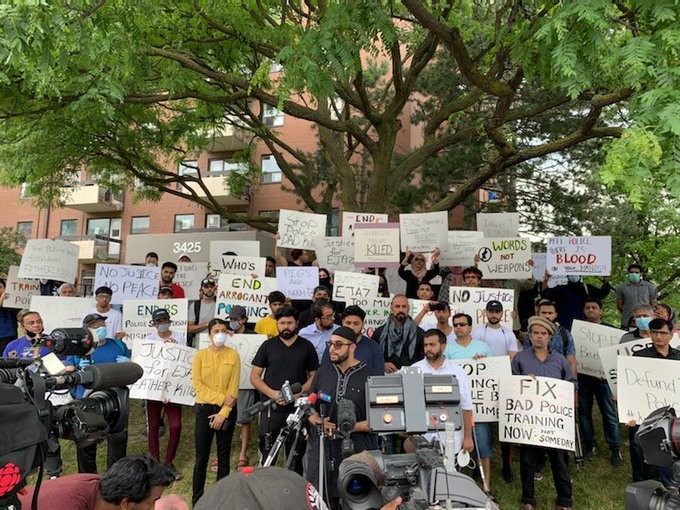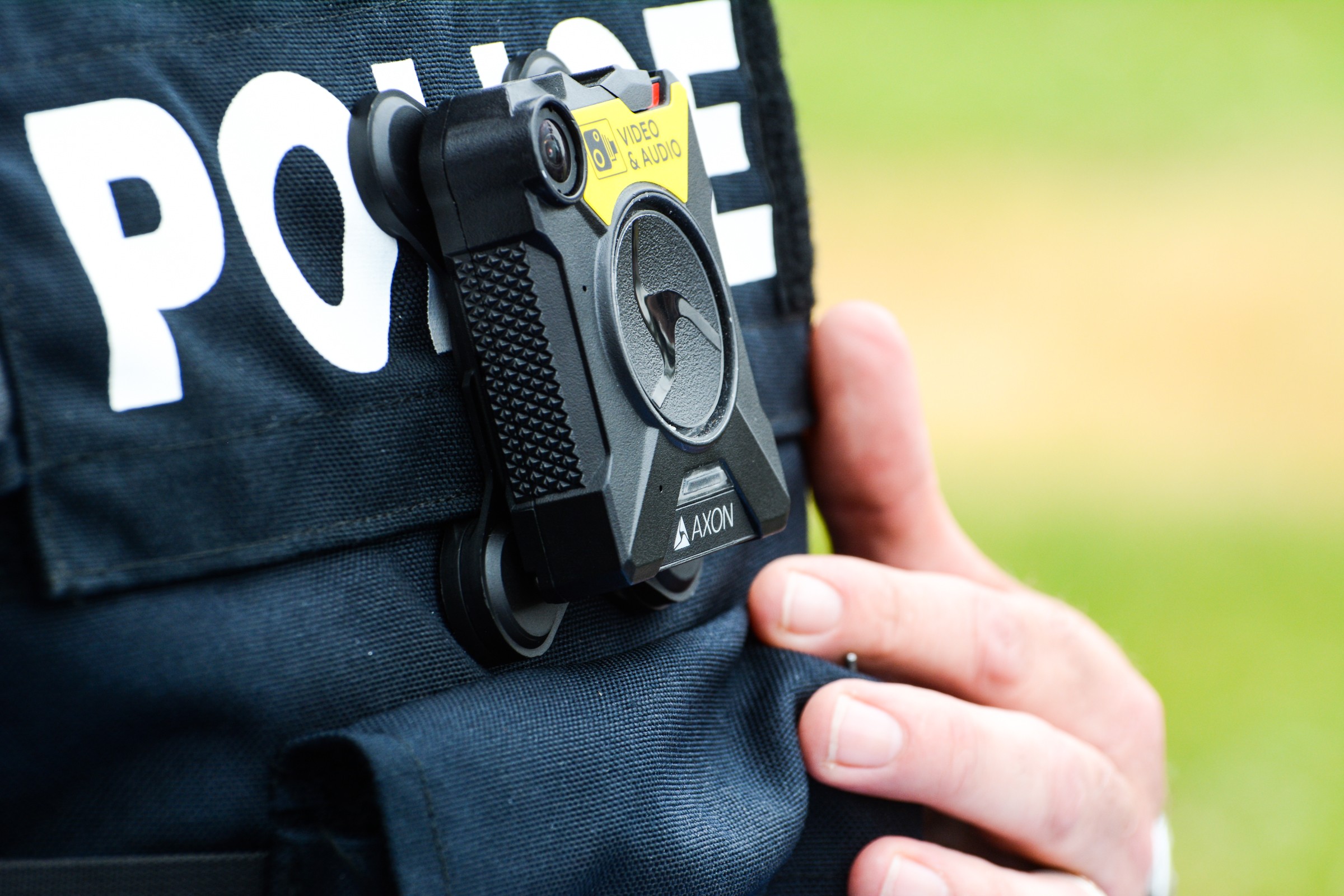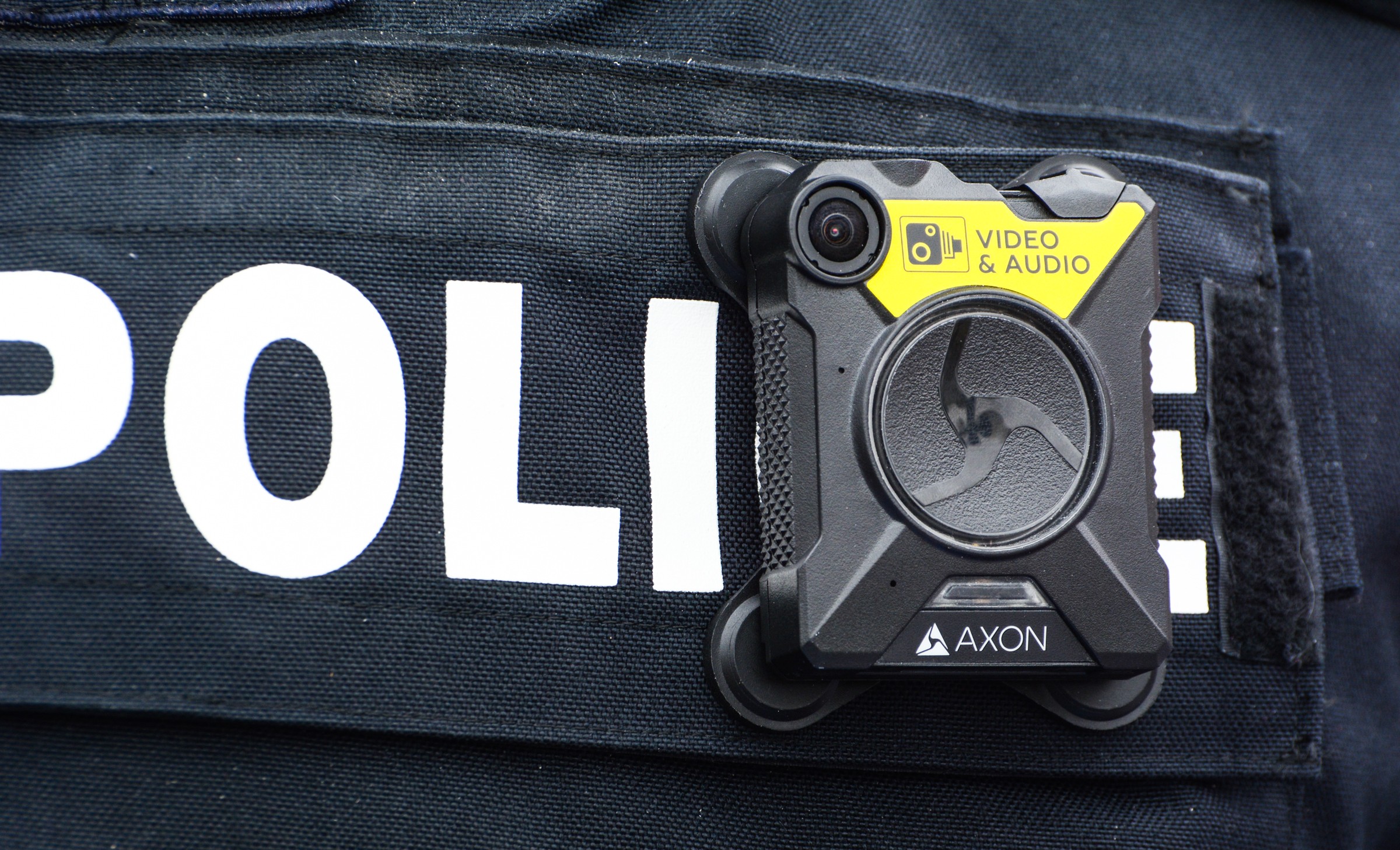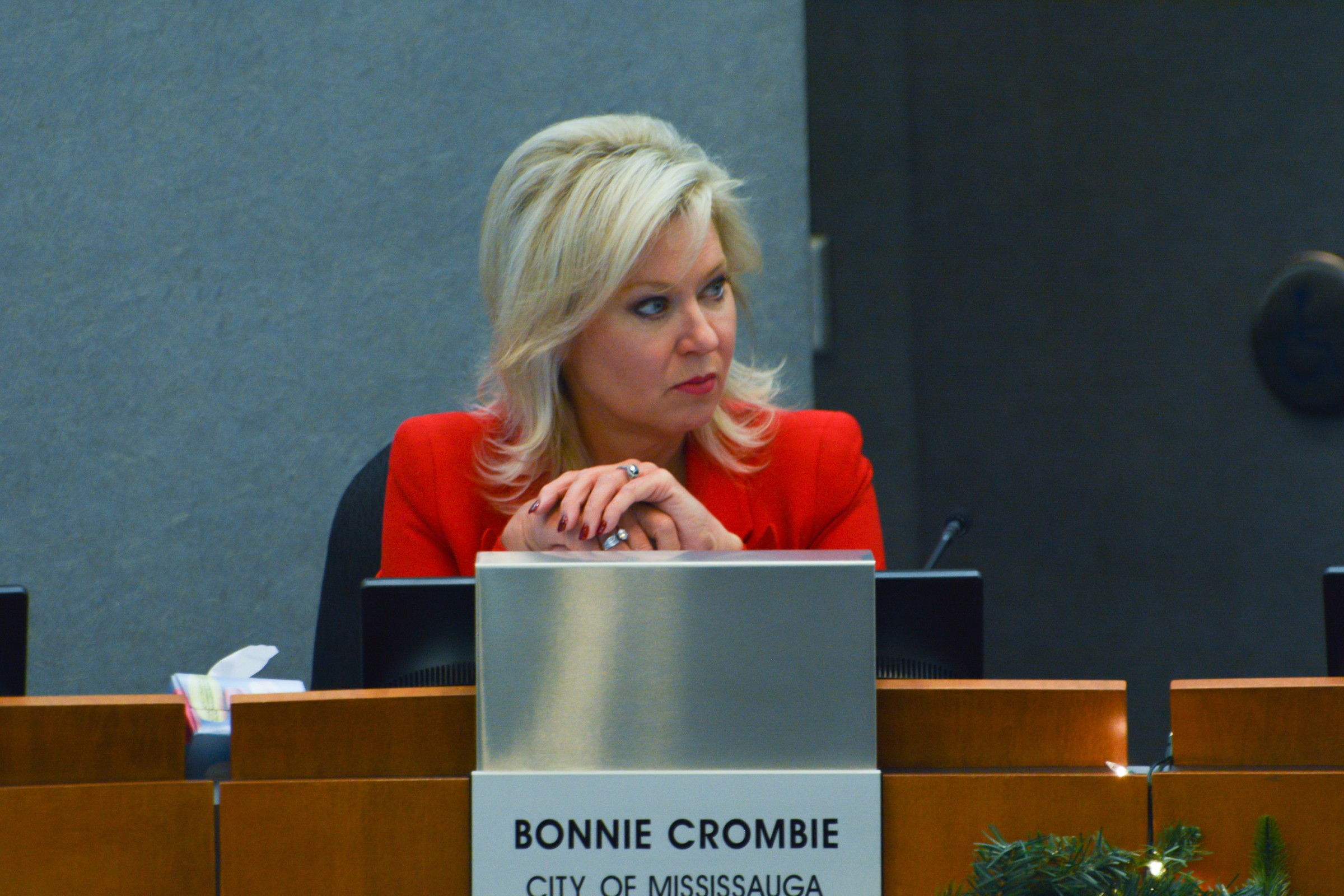
Police board green lights body cameras; members quiet on other reforms
Across North America, public demands to overhaul police departments have led to widespread confusion around how this might be done. On Friday the board that oversees policing in two of Canada’s largest cities took action on police accountability but not on the issue of funding.
The meeting of the Peel police board, its first since events have shaken members of the public in the region and around much of the world, has been viewed online more than 500 times. Members endorsed the use of body-worn cameras, suggesting the move would allay many of the concerns being expressed, but they danced around the more controversial and complex matter of defunding the police.
The amount of public dollars being spent on decades-old police funding models, which have focused on more officers, more equipment and more military-style weapons, with less attention to service-delivery and community building, has come under fire recently.
Calls for a dramatic shift in public safety priorities have gained particular prominence in Mississauga and Brampton following the death of 62-year-old Ejaz Choudry, a Malton father of four who was shot by Peel police Saturday, June 20. The shooting, currently being investigated by the Special Investigations Unit, sparked a series of protests in Mississauga and renewed calls for police accountability.

The death of Ejaz Choudry in Malton has triggered widespread calls for police reform in Peel.
In response to pressure from citizens, community groups and politicians demanding better transparency of officer encounters with the public, the board approved the introduction of body-worn cameras for 1,200 frontline officers at an annual cost of $1.4 million.
Peel police will award the contract to Axon, an Arizona-based company that manufactures a wide suite of equipment used in law enforcement, and will introduce the technology by the fall.
In tandem with the project, the force plans to upgrade its digital evidence management strategy. As policing modernizes, a significant amount of digital data is kept and collected, something Peel is addressing with a more up-to-date approach. In the future, this system will include dashcam footage, body cameras, electronic notes and other digital evidence for analysis.

Body cameras for Peel police officers will be provided by Axon and may look similar to the one above, seen during the launch of a pilot project to equip Durham Regional Police officers with the devices.
Board members were flooded with almost 100 letters sent by residents advocating for reform and a more holistic approach to policing. Some specifically criticized the introduction of body-worn cameras, fearing the move will distract from the broader need to strip down police departments, look at what works and what doesn’t and then rebuild them in close partnership with other agencies that can focus on better service delivery to deal with “upstream” issues such as mental health and acute mental health crises.
The board, which will not meet again until September, governs the force that patrols Brampton and Mississauga (Caledon is policed by the OPP) and handles all key policy decisions. It approves annual budgets and sets broad direction. It is not involved with day-to-day operational directives, overseen by the chief and other senior brass.
Chair Ron Chatha said there were more correspondences, most calling for a new funding model, received for Friday’s meeting than ever before.
Many of the letters, which can be viewed by the public, described a current system designed to fight crime, not manage difficult situations like mental health crises, youth conflict, suicidal ideation, addiction withdrawal and overdoses, and sexual violence including domestic abuse.
The problem is that most public safety engagement has fallen into the realm of policing largely because forces have the 24/7 staffing capacity and infrastructure to deal with emergencies around the clock, even though officers are ill-equipped to deal with an increasingly large number of the calls they are asked to address.
Another issue in Peel is a force that does not represent the complex racial and cultural diversity of the two cities. The modern realities of policing – where officers deal with mental health crises, sexual assault and homelessness more than homicides or property crimes – reveal a mismatch: Officers are recruited, trained and equipped for the wrong type of work.
In response to a history of strained relationships with racialized communities, the majority of people who wrote to the board believe body-worn cameras will not solve the systemic bias prevalent within Peel police. At best they’re seen as a Band-aid and at worst a distraction.
“Body-cams will not help people because police often arrive in the aftermath of violence,” Simrat Khabra wrote in one letter. She feels that body cams will not teach officers to appropriately assess risk and de-escalate a volatile situation.
Khabra argues the technology is a weak attempt to address the real issues. “I believe body cams will create an illusion of accountability and safety thereby allowing us to ignore persistent problems plaguing the Peel Police,” she wrote.
Another resident, Bushra Asghar, said: “I am a 24-year-old queer woman of colour and when I was sexually assaulted I did not call the police because I believe they do not have the training and capability to help me during a time of crisis.”
Another frustrated citizen from Mississauga, Debby Nunes, said that body cameras do not solve the root of the issue and are an “expensive band-aid” solution to create the illusion of police action.

Many Peel residents have written to the Peel Police Services Board in frustration, believing the board is using the technology as a Band-aid solution for issues that will take much longer-term, complex police reforms.
Referencing the stack of heartfelt and personal letters, board member Len Howell said he felt they did not represent the view of the whole community. Instead, he suggested they came from a coordinated group.
“I don't think the deputations are a common attitude. Likely [they’re] coming from a common source,” Howell said. “I cannot be more supportive of body cameras.” It’s unclear how Howell determined this on his own or how he knows what the “common attitude” is. He is a former Peel police officer who left the force after almost a decade and has since worked in real estate.
While board members wholeheartedly embraced body-worn cameras as necessary for the future of policing, discussion about the broader issue of police funding was noticeably absent. Some touched briefly on the philosophy of policing, but few solutions or tangible actions were presented during the publicly streamed Zoom meeting.

Police Services Board member Len Howell supports the use of body cameras for police in Peel and does not believe the stack of letters received from local residents calling for the board to do more on the topic of reforming the police is a "common attitude".
“You have all been heard,” Chatha told the residents who wrote to the board to ask for defunding. His words were not reflected in any tangible actions taken by the board Friday.
Mississauga Mayor Bonnie Crombie, who has repeatedly said the board will take a different approach to the 2021 budget, mentioned reforms, but did not go into specifics. “There are lots of reforms that we will be considering going forward,” she said. “It’s nothing we’re going to commit to right here, right now, but as we go through the budget process, we will.”
Friday’s meeting, the last till September, was the perfect opportunity to take preliminary action, but no such move was made.
The board will not reconvene until after the summer break, with the 2021 budget likely already being shaped. In the meantime, the board did not ask for more information, a workshop or other opportunities to at least bring stakeholders and research to the table with the aim of exploring approaches to police restructuring and a new budget designed to fit a different model.
It could be a signal that, other than body cameras, Chief Nishan Duraiappah and his recently restructured senior team will take the lead on the police budget, not the board that is supposed to govern over the process.
It would be nothing new, as the last two decades featured budgets conceived, designed and presented entirely by the senior officer team, while the board and regional council, which has to give final approval, effectively rubber stamped whatever the white shirts wanted.
Mississauga Ward 5 Councillor, Carolyn Parrish, who sits on regional council and represents Malton where the most recent fatal shooting by an officer took place, said changes need to be made to how police approach delicate situations.
“We’re missing our local station that we had before and is going to be reopened. We’re missing mental health workers. We’re missing plain clothed, young [officers] to go into schools … [and get to know] the kids and hang out,” she told The Pointer, listing a few progressive reforms that could benefit her community.
Parrish drew on a report published in 2014, entitled “The Blue Line or the Bottom Line of Police Services in Canada?” In the report, author Christian Leuprecht argues for policing where frontline officers are used for dangerous situations and other more traditional tasks, while more inexpensive and appropriately trained civilians respond to many frontline situations.
Investigations into some fraud crimes, other cyber-related crime and mental health calls, even burglaries are a few of the areas where police may not be the most efficient use of resources.
“One way to distinguish core policing responsibilities is to separate out those that are genuinely dangerous and need to be carried out by trained, professional sworn members,” he wrote. “Civilian investigators are less apt to be called away by an urgent call from the dispatcher, can spend more time at the crime scene, and specialize in a smaller number of tasks, including calming victims. Once a burglary is over, the on-site threat has dissipated so there is no real need for a sworn member to attend.”
From mental health to note-taking and interviewing, Leuprecht argues that non-officer members of the force are better equipped to perform the job. Instead of simply defunding the police, this argument calls for the shift of some funding away from frontline officers.
But no one on the Peel board asked those questions.
Nobody asked for a report on solutions to policing. Nobody suggested a presentation by experts. And no real background work was suggested over the summer.
“They [the board] have no training in police services, so when the police and the strong unions come forward and say that the world is going to end … if we cut one frontline officer... it carries weight,” Parrish said.
On Friday, Crombie illustrated the lack of any real action, despite claiming earlier, in the face of wide public backlash, that the 2021 budget would be looked at through a different lens. Refraining from creating a motion for a new funding approach, the mayor gave her colleagues a reading list. She asked staff to send copies of a report into the practice of carding and other models of police delivery to board members to read up and equip them to discuss the concepts at a future meeting.

Mississauga Mayor Bonnie Crombie
“We as a board need to have those healthy conversations about what we are prepared to do,” she said. September’s meeting will reveal if she intends to back up her words with action. She did so in 2015, when Crombie boldly took on former chief Jennifer Evans, demanded the force stop the practice of carding, and brought forward a motion that was ignored by the since departed chief. But that was half a decade ago and a whole new set of problems has clearly emerged.
On Monday in neighbouring Toronto, City Council members rejected a motion designed to begin defunding the police; 16 councillors voted down a motion to cut the city’s police budget by at least 10 percent next year, with eight supporting the failed move. It was the first real consideration around police funding by politicians in the GTA since calls to defund or even abolish police forces began. Instead, Toronto Council passed a much less controversial motion that will allow it to review the police budget line by line, create a non-police response team for mental health calls and introduce body cameras by 2021.
In Peel, where the force is feeling the pinch of the pandemic, extra costs such as personal protective equipment and additional cleaning have left the department with a deficit of roughly $2 million.
Body-worn cameras specifically (and not the wider digital evidence strategy the police are pursuing) will come in at around $1.4 million per year for an initial term of five years. Early estimates suggest it will cost $7 million across the next half-decade, but with a contract yet to be finalized, it could be more.
According to a report presented to the board, the technology will enhance public and officer safety, build trust, act as a tool to resolve complaints and provide evidence for court trials.
Over the years a number of pilot projects for body-worn cameras have been initiated by Canadian police forces, but due to the high costs associated with the technology, most were not extended to service-wide implementation.
“There will be a cost to this, but I believe that this is the right thing to do even if there is a cost. The chief supports this decision,” Brampton Mayor Patrick Brown previously told The Pointer.
Exactly how body-worn cameras will become a part of the force’s daily workings remains unclear. The new equipment will require significant processing power, while officers and the public will need to become familiar with its impacts on their lives and privacy.
The technology can operate constantly or intermittently. Officers can be in charge of turning it on or artificial intelligence can be used to trigger the cameras.
Meanwhile, the new chief once again pledged that other changes are coming.
“The model of community policing at Peel Region is about to change,” Chief Duraiappah told the board. “This will be reflected in how we deal with issues such as mental health and addictions, intimate partner violence, property offenses or violent crime.”
The board that is supposed to govern the force does not seem to be involved in the creation of these plans.
Email: [email protected]
Twitter: @dudha_aishwarya
Email: [email protected]
Twitter: @isaaccallan
Tel: 647 561-4879
COVID-19 is impacting all Canadians. At a time when vital public information is needed by everyone, The Pointer has taken down our paywall on all stories relating to the pandemic to ensure every resident of Brampton and Mississauga has access to the facts. For those who are able, we encourage you to consider a subscription. This will help us report on important public interest issues the community needs to know about now more than ever. You can register for a 30-day free trial HERE. Thereafter, The Pointer will charge $10 a month and you can cancel any time right on the website. Thank you.
Submit a correction about this story


